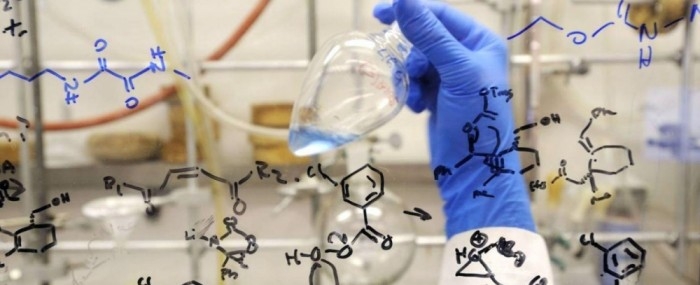

Coniferol obtained from sugarcane and wheat straw. The compound has applications in the food, cosmetics and pharmaceutical industries (photo: Felipe Maeda / Agência FAPESP)
Researchers are looking for partners to refine process that converts sugarcane bagasse and wheat straw into high-value compounds.
Researchers are looking for partners to refine process that converts sugarcane bagasse and wheat straw into high-value compounds.

Coniferol obtained from sugarcane and wheat straw. The compound has applications in the food, cosmetics and pharmaceutical industries (photo: Felipe Maeda / Agência FAPESP)
By Elton Alisson | FAPESP Innovative R&D – Sugarcane bagasse and other kinds of agricultural waste biomass can be used as raw materials for the manufacturing of fine chemicals. To this end, however, it is necessary to develop technologies that are competitive with the processes currently used by the petrochemical industry to obtain these high-value compounds for specialized applications.
A group of researchers affiliated with institutions in Brazil and the United Kingdom has succeeded in advancing in this direction by developing a novel simplified biotechnological route to convert sugarcane bagasse and wheat straw into fine chemicals with applications in the food, cosmetics and pharmaceutical industries, among others. The researchers are now looking for partners to commercialize the technology.
The new process was developed during a project supported by FAPESP under the aegis of its Bioenergy Research Program (BIOEN) and is described in an article published in the journal Green Chemistry.
The researchers work at the University of Sorocaba (UNISO) and the University of Campinas (UNICAMP) in São Paulo State, Brazil, and at the University of Manchester and the University of Warwick in the UK.
“We managed to develop a biocatalytic route to produce coniferol and other aldehydes and aromatic acids directly from agricultural waste biomass,” Fábio Márcio Squina, a professor at UNISO and principal investigator for the project, told FAPESP Innovative R&D.
Coniferol is so valuable that a gram can cost as much as €300. It is used to synthesize various chemicals that are equally costly, such as pinoresinol, a hypoglycemic agent, and sesamin, which has anti-hypertensive properties and helps lower cholesterol levels. Coniferol is also a floral scent precursor and has the potential to be used by the perfume and cosmetics industries in developing fragrances.
In the petrochemical industry, coniferol is obtained by processes of chemical synthesis involving complex routes or the use of hazardous reagents. These include sodium borohydride, as well as other toxic products, transition metals and complex catalysts that accelerate chemical reactions.
To develop a simpler process that eliminates the use of hazardous substances and mitigates the environmental impact, the researchers produced biocatalysts and applied them directly to agricultural waste. In this manner, they succeeded in releasing ferulic acid from lignocellulosic biomass and converting it directly into coniferol.
“By means of a cascade of three catalytic enzymes developed in recent years, also with applications in biofuel production, we produced coniferol in a simplified process with a conversion yield as high as 97%,” Squina said.
Combination of enzymes
One of the catalytic enzymes used in the new process is a feruloyl esterase (XynZ). Produced by a bacterium in the genus Clostridium, the enzyme characterized by the Brazilian researchers is capable of removing ferulic acid from plant biomass. Ferulic acid is an aromatic compound accounting for approximately 2% of lignocellulosic biomass.
Another of these enzymes is aldo-keto reductase (AKR). Produced by the Asian subterranean termite Coptotermes gestroi and discovered by the Brazilian scientists, AKR can catalyze coniferol production. However, another class of enzymes called carboxylic acid reductase (CAR) is needed to produce the compound from lignocellulose-derived ferulic acid.
Different combinations of AKRs and CARs were tested while PhD candidate Robson Tramontina was at the University of Manchester with a Research Internship Abroad scholarship from FAPESP.
The results of the tests showed that the best combination used a CAR derived from Nocardia iowensis, a species of bacterium found in soil and described by the British scientists.
Once the ideal combination was found, a strain of the bacterium Escherichia coli was developed to produce recombinant genes from C. gestroi and N. iowensis.
In contact with lignocellulosic material such as sugarcane bagasse and wheat straw, the combination of the bacterium with the enzyme feruloyl esterase triggered a cascade of chemical reactions that led to the production of coniferol.
“This new route enables us to obtain not just coniferol but also other high-value aldehydes and aromatic alcohols that have applications in a range of industries,” Squina said.
Search for partners
The researchers are now working on ways to intensify the process and on economic feasibility studies.
Preliminary calculations show that the new biotechnological route can increase the value of sugarcane bagasse and wheat straw up to 5,000-fold and multiply the price of ferulic acid by a factor of up to 75 when these residues are converted into coniferol.
“We’re currently engaged in a search for partners interested in developing the technology for industrial use and possibly adapting it to other raw materials or to produce other commercially worthwhile compounds,” Squina said.
The Green Chemistry article “Consolidated production of coniferol and other high-value aromatic alcohols directly from lignocellulosic biomass” (doi: 10.1039/C9GC02359C) by Robson Tramontina, James L. Galman, Fabio Parmeggiani, Sasha R. Derrington, Timothy D. H. Bugg, Nicholas J. Turner, Fabio M. Squina and Neil Dixon can be read at: pubs.rsc.org/en/Content/ArticleLanding/2019/GC/C9GC02359C#!divAbstract.
Republish
The Agency FAPESP licenses news via Creative Commons (CC-BY-NC-ND) so that they can be republished free of charge and in a simple way by other digital or printed vehicles. Agência FAPESP must be credited as the source of the content being republished and the name of the reporter (if any) must be attributed. Using the HMTL button below allows compliance with these rules, detailed in Digital Republishing Policy FAPESP.




